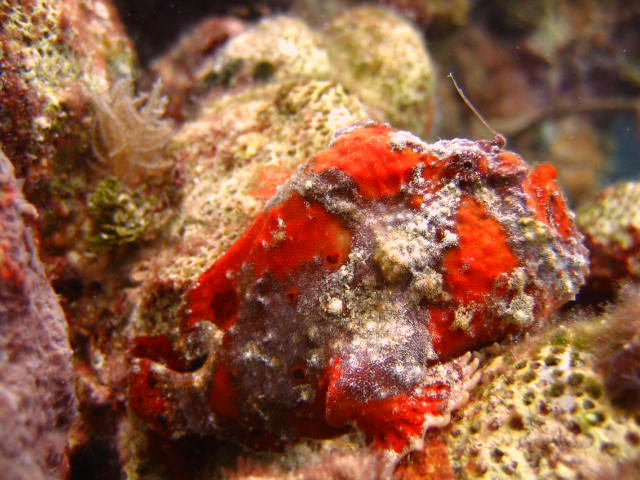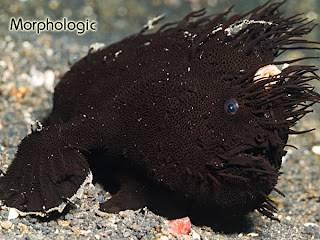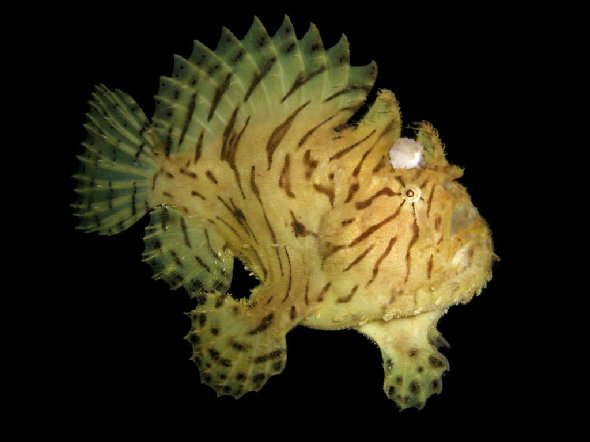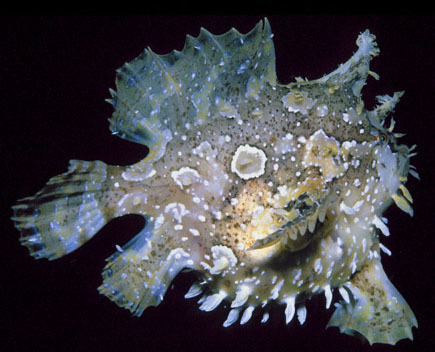This page is meant to summarize the basic information you need to keep your frogfish alive. Anyone who is really interested in keeping frogfish should read the 'Frogfish Files' thread at Reef Central. I have a link to this thread in the right column. There is a lot more detailed information on that thread.
Recommended species
This is a list of commonly kept frogfish by the aquarium hobbyists. Frank Schneidewind (Coral Magazine) recommends only the smaller species should be kept and claims that H. histrio and A. commerson are completely unsuitable for the aquarium because of their larger size.
Selecting a frogfish
Signs of healthy lophiiform fishes:
When selecting a frogfish, choose one that shows the following characteristics:
Signs of unhealthy lophiiform fishes:
Avoid buying a fish that keeps a gill closed while pumping the other, or is completely inactive.
Acclimation
Your frogfish should be permitted to settle in at the local fish store for a week or more.
Transporting
To catch your frogfish, use a plastic bag or specimen container, not a net. Move slowly so as to not over stress the frogfish. Do not ever expose your frogfish to air, it is hazardous to a frogfish's health if it sucks air into it's stomach.
Feeding schedule
One to two feedings per week.
Treating disease
Recommended foods
When feeding your frogfish, always assure that food is no larger than 30% of the fish’s body size. It is best to feed your frogfish a variety of foods. Professor Ellen Thaler claims that frogfish will eventually stop eating and die of starvation if they are not frequently fed live food.
Live Food
Feeders should be kept for at least two weeks before feeding them to your frogfish. Shrimp and small bony fish of marine origin are favored, but enriched guppies or mollies that have been acclimated to saltwater are a good alternative. Ellen Thaler kept two wartskin frogfish alive on mainly “saltwater” guppies for over tree years.
For information on raising live food for your frogfish, see my article here.
Frozen Food
Thawed food should be rinsed in tap water before feeding it to your frogfish.
Sensitivities - things to avoid
Recommended aquarium co-inhabitants- compatible corals, invertebrates, fish
It is generally recommended that frogfish are best kept in a species tank (where they are the only species of fish), but here are other possible co-inhabitants that will be good tank mates.
Recommended aquarium properties- filtration, lighting, flow, etc
In the wild, frogfishes prefer rocks, corals, or sponges, where they choose an elevated spot to perch on and wait for potential prey.
Any lighting will due, as long as it enough for the type of coral in your aquarium.
Breeding
Male and female pair up when the female’s abdomen becomes swollen with hydrated eggs. Male stays near the female until she is ready to release the egg raft. When the egg raft is release the male releases sperm and fertilizes the eggs externally. Generally the male and female separate temporarily for a period of days or weeks after spawning occurs. Many pairs stay together for the whole spawning season.
Color Changing
Provide interesting textured/colored corals to encourage your frogfish to change color.
References:
- Professor Ellen Thaler : Saltwater guppies as Live Food : Coral Magazine
- Professor Ellen Thaler : Notable experiences with Frogfishes and Thoughts on their Care in the Aquarium : Coral Magazine
- Frank Schneidewind : Frogfishes – the family Antennariidae : Coral Magazine
- Scott W. Michael : Frogfish Behavior Notes from the field : Coral Magazine
- Scott W. Michael : Frogfish Reproduction : http://www.coralrealm.com/fish/features/frogfishreproduction.html
- Anthony Calfo : Antennarians – Frogfish : Reef Hobbyist Online Magazine
- Frogfishes of the World
- Reef Fishes Volume 1
- Reef Central – Frogfish files thread
- http://www.frogfish.ch








